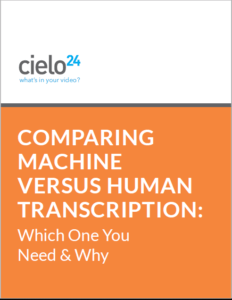All about Media Data, and why you should care. Media data is the entirety of a…

Video Metadata versus Media Data: How they Impact SEO
Video Metadata is descriptive data and media content. That may sound a little ambiguous (didn’t our teachers always tell us not to use the word itself in the definition?). But in our technical world of 1’s and 0’s literally, everything online is data. And sometimes we need to explain what a certain set of data is saying in order to help the internet understand it.
For example, the internet is a text-based engine. While video and other forms of media are quickly becoming the predominant source of online content, the internet still can’t crawl or read video for indexing and ranking. Video metadata explains the video to the internet to let search engines see and share the video file. The same is true for images, tables, columns, keys, indexes, subjects, keywords, titles, and even languages.

Video media data is the evolution of video metadata – it is a set of information that describes the whole – not just a part.
While metadata scratches the surface of video SEO with some general categorization, using video metadata alone is like bringing a knife to a gunfight in the advertising world. Media data, on the other hand, provides the entire video intelligence in text form, including transcripts, captions, topics, keywords, subjects, and AdWords. Media data allows search engines and viewers alike access to the entire database of your video in any way you want, where metadata targets only human-added tags, titles, and summaries.
At a dizzying pace, video SEO, content, and advertising depend on high- quality media data to be successful. Media data provides a deeper dive into the information you provide search engines.
Think of Metadata and Media Data this way:
- Video metadata is the “About” section on your Facebook page.
- Captions are your Facebook posts before you were allowed to add images
- Media data is the whole shebang — your profile, posts, pictures, and list of likes and every other scrap of information
A Deeper Look at Video Metadata and SEO

Where targeting video metadata was once the most popular default behavior of content creators, now it seems it is being neglected in favor of more “advanced” SEO. The reality is that video metadata remains a critical aspect of SEO.
Though no longer a leading component affecting ranking, careful consideration of your video metadata can lead to increased click-through rates, which in turn builds backlinks. The Title tag, Description tag, and Alt attribute are the most video metadata components critical to SEO.
Title
Your title can be up to 100 characters long. With so few characters, it’s important to make each one count. Include the top two or three keywords, product or brand name, and webpage topic or title. Ask yourself, is my webpage title strong enough? Avoid poor, misleading, or lack-luster text. Ask yourself, would I click on this title?
Description
Your description can be any length, but search engines cut off the display after about 160 characters, so make the first portion the strongest. Ask yourself if the description is as enticing or as relevant as your user would expect.
The Alt Attribute
The Alt attribute of the Image meta tag is another opportunity to embed keywords. Not only does the tag make your webpage more accessible by including a textual description of media, but it improves your relevance on an image search.
Using Video Media Data to Further Optimize SEO

 You use your video media data the same way you would use any other content; place it within the body of your page and make sure that it is readable by both humans and search engines. Crawlers tend to have a hard time indexing Flash and JavaScript-generated content. When interactive transcripts and complex media data are generated using Javascript, Google will likely be unable to read your content, which seriously inhibits your ability to get a good search result ranking. Especially with video, you may be separating the page delivery from the web content delivery to avoid delayed page loading time.
You use your video media data the same way you would use any other content; place it within the body of your page and make sure that it is readable by both humans and search engines. Crawlers tend to have a hard time indexing Flash and JavaScript-generated content. When interactive transcripts and complex media data are generated using Javascript, Google will likely be unable to read your content, which seriously inhibits your ability to get a good search result ranking. Especially with video, you may be separating the page delivery from the web content delivery to avoid delayed page loading time.
Our Enterprise customers have access to our Video Wrapper 3.0, which displays all media data features in one single video viewing experience, as well as interactive video search and advanced sharing capabilities – all for free.
Video Metadata: Transcripts and Captions

You Choose!
At cielo24 we offer a Self Serve web app that allows you to get started ordering video transcripts and captions immediately, without the wait for contracts or quotes. You can select a preliminary amount of free machine-based transcriptions and captions – which provide a lower level of accuracy guarantee, or human-verified transcriptions beginning at less than a dollar per minute. For more information on our video transcription, captioning and video intelligence solutions, contact us online or call us at 1-855-243-5624.
cielo24 is removing barriers to increase video marketing ROI, searchability and compliance for all your videos!
Take a Video Captioning test-drive >>



